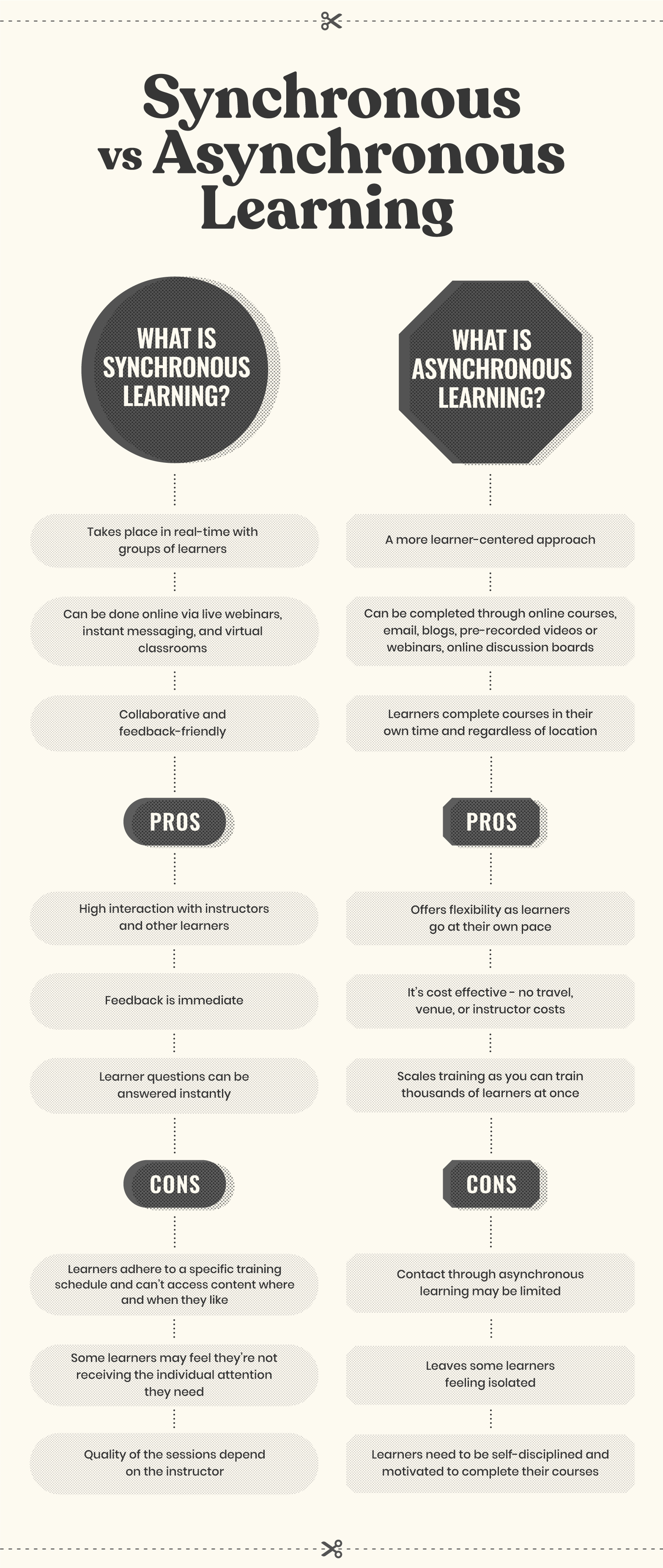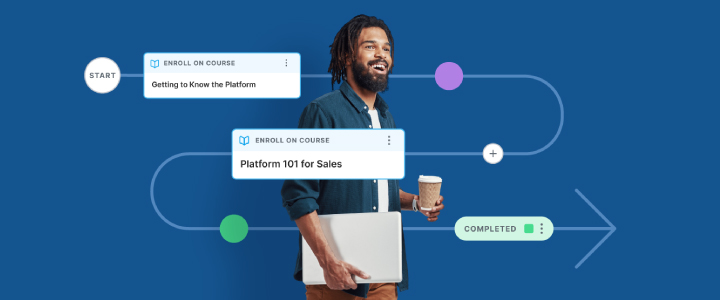
4 min reading time
Synchronous vs Asynchronous Learning: Which is Right for Your Learners?
Online training has opened up a world of possibilities for businesses. Whether learning a new skill or completing mandatory training, as a business you’ll need to decide one thing when implementing it – whether synchronous or asynchronous learning is the most effective way to support your learners.
Depending on the learning objective, learners can benefit from both synchronous and asynchronous learning. Each offers its bright sides, and of course, its drawbacks. But which one is right for you and your learners?
Here’s a quick explainer of each, the pros and cons of both, and how you might best utilize these methods.

What is synchronous learning?
Synchronous learning is any type of learning that takes place in real-time, where a group of people are engaging in learning simultaneously. Although learning occurs at the same time, learners don’t have to be there in-person, or even in the same location. Synchronous learning enables learners to ask questions and receive answers on-the-spot, while also collaborating freely with their co-learners.
For employee training, synchronous learning is a popular choice. It’s a method that lends itself well to learning about updated company policies or new software that’s being rolled out. When done right, it’s also useful for customer and partner training as it creates an invaluable feedback loop.
Some examples of synchronous learning include:
- Live webinars
- Video conferencing
- Virtual classrooms
- Instant messaging
What is asynchronous learning?
Asynchronous learning is more learner-centered. It enables your learners to complete courses without the constraints of having to be in a certain place at a certain time. In essence, asynchronous learning doesn’t hinder learners by place or time. As long as they have access to the internet, asynchronous learners have the freedom to complete course materials whenever they choose, and from any location.
Although not taking place then and there, asynchronous learning still allows the opportunity for feedback. Learners are free to share thoughts and questions with instructors and fellow learners, though they may not receive an immediate response.
Some examples of asynchronous learning include:
- Online courses
- Blogs
- Pre-recorded video lessons or webinars
- Online forums and discussion boards
Synchronous vs asynchronous learning: Pros and cons
When comparing synchronous and asynchronous learning, both have advantages and disadvantages; what may appeal to one learner may not appeal to another. Let’s look more closely at some of the main pros and cons of each:
Pros of synchronous Learning:
- Because of the social nature of synchronous learning, learners can easily interact with instructors and other learners, making group activities possible.
- Synchronous learning takes place in real-time, which means learners can get immediate feedback. Ideas and opinions can also be promptly shared with fellow learners.
- Similarly, if your learners are having trouble with any of the course content, synchronous learning allows them to ask questions and get instantaneous answers.
Cons of synchronous Learning:
- Synchronous learners have to be online at a certain time, and therefore their learning has to adhere to a specific training schedule. Learners can’t access content where and when they like. To accommodate your learners and offer more flexibility, you could provide a webinar recording of the training session through your LMS.
- Due to the group dynamic of real-time synchronous learning, some learners may feel they’re not receiving the individual attention they need. This is especially true if there’s any part of the training they do not fully understand. To bypass this, try checking in on the progress of your learners by setting aside time during training for one-to-one or group Q&A sessions.
- The effectiveness of how well your learners understand the course content depends more on the quality of the instructor than the learners themselves. To overcome this, ensure your instructors receive relevant training so they’re fully prepared for their role. Requiring instructors to plan their sessions ahead of time will also ensure they’ll deliver a great learning experience for your learners.
Pros of asynchronous Learning:
- Asynchronous learning offers lots of flexibility. Although there’s usually a deadline in sight, asynchronous learners can progress at their own pace and access their course at any time they choose and from any place.
- It’s a cost effective way to train learners that are based in varying locations. Asynchronous learning means your learners can engage in courses regardless of their time zone or location.
- With asynchronous learning, learners have significantly more time to reflect on the material they are learning, which means they are likely to understand it more thoroughly.
- Additionally, asynchronous learning lends itself better to a fast-growing business. If you’ve hundreds or thousands of learners to train across the world, you can get them up to speed without the need for face-to-face training.
Cons of asynchronous Learning:
- Although learners may have access to an instructor, contact through asynchronous learning may be limited. Answers to queries cannot be given instantly (for example, learners may need to wait for an answer to an email). This can be overcome by ensuring you choose an LMS that makes communication as easy as possible.
- The lack of interaction with instructors and fellow learners leaves some individuals feeling isolated. This could lead to a lack of motivation and engagement in courses. So, combat learner isolation by focusing on creating great course content.
- Asynchronous learning is learner-centered, so those taking courses in this way need self-discipline and focus to be successful in completing the required course work. Using tools like Gamification or a Forum helps to keep your learners engaged.
Synchronous vs asynchronous learning: Which is best for your learners?
Ultimately, the method of learning you choose for your learners will depend on a number of factors – learning objectives, the types of course content you create, how you deliver your training, and the availability of your learners. However, if you have the resources, using both synchronous and asynchronous learning is a winning formula.
For example, creating a largely asynchronous course with supplementary live webinars scheduled for varying days and times, ensures that learners have the additional benefit of interacting with each other and instructors. Alternatively, blended learning is another option that supports both synchronous and asynchronous learning opportunities.
No matter which method you choose, variety is the best approach. Especially if you’re building a course; aim to keep your learners as engaged as possible by mixing different methods of content delivery. A combination of elements like video, text and images are sure to keep your learners interested.



